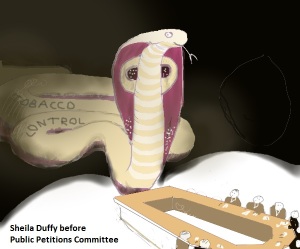I came across Sheila Duffy’s appearance before the Scottish Parliament’s Public Petitions Committee on Headrambles late last week, and it’s been bubbling away at the back of my mind for days.
Her petition starts at about 54 minutes in, and lasts about 5 minutes, and the gist of it is that she would like to remind that the Parliament that they are signatories to the Framework Convention on Tobacco Control, and she wishes to draw their attention to article 5.3 of the convention, which requires the parties to protect the policies from the vested interests of the tobacco industry, which meant that parties should have as little to do with the industry as possible. i.e. they shouldn’t admit them for consultations.
I’ve taken the trouble of roughly transcribing her little speech (emphasizing the most egregious claims). But it’s worth watching for the smirking expression on her face throughout (click to enlarge).
“Scotland has a proud record of tackling tobacco, and it’s hard for me to believe that next year will see 10 years since Scotland implemented smoke-free public places. I’d like to take a moment to remember what tobacco is. It is widely available, with 8 tobacco retail outlets for every one pharmacy in Scotland, so it’s easier to buy poison than it is to buy medicine. It is addictive and dependency-forming, and engineered to be as highly so by tobacco companies. It is primarily a childhood addiction, not an adult choice. And it is lethal to at least one in two consumers, and recent research suggests maybe two in three consumers when used long term in accordance with the manufacturers intentions. In Scotland tobacco is estimated to be responsible for around a quarter of all adult deaths recorded each year – some 13,000 lives lost early. And behind each death there are likely to be 20 people living with chronic and disabling disease caused by tobacco. So this is a major and largely hidden epidemic. And it is a commercially driven epidemic, driven by an industry with a long and well-documented history of denial, delay, and deceit with regard to health measures. And an industry that has demonstrated that its main interest lie with its profits. And because the tobacco industry is a world wide predator, the WHO developed and put forward the first and only international public health treaty, which has 180 signatories, including the UK and EU, and which covers 90% of the world’s population. Now this treaty requires parties to introduce broad-brush measures to try to reduce the harm from tobacco, so things that we already have like tobacco tax, smoke-free enclosed spaces, curbs on tobacco advertising. But this petition relates to article 5.3 of the FCTC which requires parties, in setting and implementing public health policies, to act to protect the policies from commercial and vested interests of the tobacco industry. Now that could be quite a wide instruction, but fortunately the conference of the parties developed further detailed guidance about how this article could and should be implemented…. For example, “Parties should interact with the tobacco industry only when, and to the extent strictly necessary, to enable them to effectively regulate the tobacco industry and tobacco products. Now I believe we need to raise awareness of this treaty in parliament. I believe there have been recent actions, unknowingly committed, which have gone against our obligations under the treaty. So the point of this petition is to ask parliament to consider the international treaty and its article 5.3, to think about Scotland’s obligations under it, and to develop guidance for parliamentary staff to ensure that we meet those obligations. Thank you.”
The first MSP to respond said that he didn’t smoke, but regarded smoking as a legal choice people made. Other MSPs came in even harder, even accusing her of being part of the tobacco industry, because she lived off the existence of tobacco. But in the end they conceded that maybe they’d need to find what ‘best practice’ was in other countries.
But what stuck in my mind was what a conceited little prig Sheila Duffy was. She had delivered a little potted lecture setting out TC vision of the tobacco industry selling ‘poison’ to children, all the while with an insouciant smile playing on her face. If I’d been one of those MSPs, I’d have been very angry at the way she was talking down to them.
In fact, what she was doing wasn’t ‘petitioning’ them, but threatening them. You have obligations under the treaty, so do something about them, or else…
And as I watched the menacing, smirking, slit-eyed performance, I suddenly saw Sheila Duffy as an enormous snake, which had slid out of darkness into the committee chamber, leaving half of its huge bloated bulk outside the door.
And that was enough of an image for me to work up using my new touch-sensitive tablet and Manga Studio 5. Here’s the result (click to enlarge):
It could have been better, but it pretty much captures the image that had sprung to mind, and it didn’t take all that long to do (1 or 2 hours). Indeed, it would have been done even quicker if I’d known how to use Manga Studio 5 properly.
But at least I managed to get a little grin on the mouth of the snake.

















Sheila Duffy talking to her bosses at Cancer Research UK
so do something about them, or else…
Like toss the FCTC out the door…………they can always do that!
5.3 of the convention
FCTC GAG ORDERS TO KEEP THE PEOPLE QUIET and have no debate the same as banning commenters…………
fctc gag order guidelines
11. The broad array of strategies and tactics used
by the tobacco industry to interfere with
the setting and implementing of tobacco control mea
sures, such as those that Parties to the
Convention are required to implement, is documented
by a vast body of evidence. The
measures recommended in these guidelines aim at pro
tecting against interference not only by
the tobacco industry but also, as appropriate, by o
rganizations and individuals that work to
further the interests of the tobacco industry.
12. While the measures recommended in these guideli
nes should be applied by Parties as
broadly as necessary, in order best to achieve the
objectives of Article 5.3 of the Convention,
Parties are strongly urged to implement measures be
yond those recommended in these
guidelines when adapting them to their specific cir
cumstances.
by organizations and individuals that work to
further the interests of the tobacco industry.
That means US!
What a sorry state our politics has fallen to, when the fact that a handful of MSPs actually challenged someone (albeit, in my view, not particularly robustly) from Tobacco Control, rather than – as is usual – simply conceding to their every whim and quietly slipping in ever-increasing regulations and restrictions of smokers, actually gets any attention at all. This kind of questioning, and alertness to politicians’ constitutional obligation as elected representatives to take all sides of all arguments into account is woefully absent in so many instances. McMahon tries valiantly to make the point that this petition seeks to codify treating tobacco companies differently from any other business interest in existence, but he fails to pin Duffy down with a demand for a direct yes or no answer (something which TV and radio interviewers are also often guilty of when interviewing politicians, so it’s sad that he doesn’t recognise a tactic which, I’m sure, he himself has used on many occasions to avoid giving a direct answer to a tricky question). Her consistent retreat to her one and only point of reference, “their obligation to the treaty, blah, blah, blah” was never commented on and could and should have been picked up on. If he’d really wanted to shift her from her safety-point, he should have said that perhaps their agreement to the treaty needed to be looked at and, perhaps – err – “reviewed.” Now, that would have got those shifty eyes rolling around a little and wiped that patronising grin off her face!
But good to see a bit of questioning, nonetheless.
Jax if one of them said the word reviewed the TC community would know there days were literally numbered. But the politicians actual attitudes is showing what Ive said many a time before. Watch for the signs when even the politicians are tired of hearing it! It appears that time is about here.
Well, it’s not much but it’s a start. £200 million cuts to Local Councils’ Public Health budgets.
http://www.pulsetoday.co.uk/news/commissioning-news/government-announces-200m-cuts-to-public-health-budget/20010183.fullarticle
One day…… ASH! (I hope).
I thought the MSPs came out swinging from their corner, but never landed a punch, and Sheila Duffy knew they never would. And in the end they just wanted to know what “best practice” was in other parliaments. TC is probably already compiling a voluminous report that won’t even allow them to take a phone call from a smoker.
We need to advocate the repeal of the FCTC. Tobacco control is a threat to democracy.
Not much I can add to an excellent analysis other than thanks for highlighting it AND for illustrating it so nicely!
:>
MJM
Actually, over here in the US earlier this year we had a nice little event that was almost as big a thing as the UK’s withdrawal from the FCTC would be. In our case a judge ruled that three members of the FDA oversight board on tobacco had overwhelming conflicts of interest due to their antismoking activities/connections: Samet, Henningfield, and Benowitz. Here’s a comment I left at an article about it earlier:
,
,
,
Very interesting. Henningfield and Benowitz were also fundmental movers in the Orwellian redefinition of the word “nicotine” so that it would apply to tobacco products in the Nancy Reagan era of “Just Say No To Drugs!” hullabaloo. That redefinition was vital in encouraging the application of the “Save The Children!” propaganda element that is always so vital in whipping up popular emotions in wartime or in any conflict where one group is being pitted against another, and the 1987 Henningfied/Benowitz NY Times article ( http://www.nytimes.com/…/nicotine-harder-to-kickthan… ) played it perfectly.
I am not as familiar with the details concerning Samet, but Carol AS Thompson has evidently devoted an entire page of her Smokers History website to the fellow and his shenanigans ( See: http://www.smokershistory.com/Samet.htm ) If Carol’s analysis of Samet’s history is accurate (and I see no overt reason to question it) then his presence on that panel represented a lot more than a casual conflict-of-interest.
,
,
,
As noted, not as big as an FCTC rumble but nice nonetheless to see them yanked.
– MJM
Mike Sammet and his Cronies were even behind the Cell phone brain cancer Farce study not that long ago. The man is a virtual research junk science agenda machine for the left.
Sorry, the URL broke. Let’s try this way, and if it doesn’t work I’ll turn it into a bitly:
or
http://www.nytimes.com/1987/03/29/magazine/nicotine-harder-to-kickthan-heroin.html
Wow. You’re really good at illustrating, Frank.
Can you do a TC ‘bow before us’ constrictor, swallowing up freedoms, wealth, compassion..?
An excellent comparison Frank . These fascists need stopping.
Just like the rest of her TC cohorts, Sheila Duffy has no scientific (let alone medical) background and is completely unqualified to be a spokesperson on matters of health. This trend alone is maddening.
Source: http://www.ashscotland.org.uk/about-us/our-people/sheila-duffy/
Fife where she currently lives with her partner and two daughters
I gather that means her Lesbian Lover/Partner
The word partner is usually a dead giveaway. In her case, I wouldn’t doubt it. I wonder if she’s into S&M, like Gertrude Stein and Alice B. Toklas were? Dildos at ten paces.
The corporate world uses ‘partner’ now for everyone. You can’t tell these days.
And using a dildo doesn’t make you cunt – being a smug, bansterbator does ;)
Your illustration reminded me of an earlier example of ASH snakes in the grass (1990) – which is exactly as I saw them. Many have seen this before, but it is worth showing again just to remind us what sort of slime we are dealing with.
Wrong choice Harley – that film was a pile of crap.
It was one of the greats as far as americans are concerned.
And the Scots. Indeed, most Anglophobes…
How Effective Are Anti-Smoking Ads?
November 23rd, 2015 Health
Joel Keller recently ranted about “inefficient” anti-smoking ad campaigns. Here’s what he gets wrong about the bottom line.
We came across this article by Joel Keller in Slate, criticizing some “extreme” anti-smoking ads that he considers “maddeningly manipulative.”
Advertising that’s manipulative? We’re shocked. Not.
Getting 100,000 smokers to quit, that sounds pretty awesome. Let’s make a cost-benefit calculation. To start, we need to know how many quality-adjusted-life-years (QUALYs) is that? We assume 100,000 additional quitters, not 100,000 people who would have quit even without the ads.
We put the question to Google: “How many years of life do you save by quitting smoking?” The search engine came up with this: Quitting Smoking Can Add 10 Years to Life. “Could” add 10 years, huh? Let’s split the difference and say five life-years per quitter, or just call it five qalys.
And how much is a qaly worth? One way to find out: Google “how much is a qaly worth,” and we are sent to a New York Times article that says, “a year of life is worth at least $100,000.”
Now let’s get back to Keller’s question. Is it really “an annoyingly inefficient use of resources” to “manipulate the emotions and scare the crap out of millions just to get 100,000 people to quit”?
The manipulating emotions and scaring the crap out of people don’t bother us so much—this all seems pretty trivial compared to getting a hundred thousand people to quit smoking—so let’s go to the “inefficient use of resources.”
The estimated dollar benefit of the ads is (100,000 quitters) x (5 qalys per person) x (100,000 dollars per qaly) = 50 billion dollars.
Maybe you don’t buy the $50 billion number. Maybe you don’t really think the ad campaign caused 100,000 people to quit. Maybe you think quitting smoking doesn’t really save you on average five years of life—maybe Kenneth Ludmerer (PDF) is correct that smoking doesn’t even cause lung cancer—or maybe you think that $100,000 is too much to pay for a year of life.
The point is, though, if you want to argue against the CDC’s ad campaign, you have to make at least one of these arguments. And then you’ll have to deal with the fact that the campaign didn’t cost anything close to 50 billion bucks.
If you want to argue against the CDC’s ad campaign, then you’ll have to deal with the fact that the campaign didn’t cost anything close to 50 billion bucks.
We can Google that too: “Cost of CDC anti-smoking campaign.” We found a press release from the CDC:
The 2012 Tips From Former Smokers campaign spent only $480 per smoker who quit and $393 per year of life saved, according to an analysis by the Centers for Disease Control and Prevention. The results of the study were published today in the American Journal of Preventive Medicine.
Interesting, The CDC’s cost-benefit calculation is a bit more conservative than our crude guesses above. They estimate that quitting saves, on average, only a bit more than one year of life, and they value a year of life at only $50,000.
Courtesy: The Daily Beast
http://dailycapital.pk/how-effective-are-anti-smoking-ads/
maybe Kenneth Ludmerer (PDF) is correct that smoking doesn’t even cause lung cancer
The pdf linked to by The Daily Beast (Andrew Gelman’s “Statistics for Cigarette Sellers”) only mentions Ludmerer in passing and gives no details about his views on the subject. The rest of the article is the usual TC tripe, mostly in praise of Robert Proctor…
http://www.ncbi.nlm.nih.gov has the 1981 telephonic deposition of Kenneth M. Ludmerer:
Click to access ChanceEthics4.pdf
The preceding link is to the Gelman article. Ludmerer:
Click to access rlkp0018.pdf
Slip-up: Ludmerer’s deposition is from 2001, not 1981.
Im just posting the story I didn’t delve into its claims
I read Ludmerer’s deposition. He was mainly being questioned on the state of scientific knowledge from the 1920s up to 1950. I thought he was a good expert witness, careful to point out what was outside his area of expertise in the face of some very mischievous lines of enquiry, particularly those involving hypothetical scenarios, I thought. He covered the methodological weaknesses in those early days and the evolving debates over the reliability of the newer epidemiological model over the pre-existing experimental model plus the added difficulties of applying these methods to chronic diseases rather than acute, (or sub-acute) ones. Basically, his view regarding smoking and lung cancer seemed to be that it would be a mistake to say that a cause-and-effect had been demonstrated AT THAT TIME.
This from Michael Siegel:
http://tobaccoanalysis.blogspot.ca/2015/11/thanks-to-invalid-nejm-formaldehyde.html
This from several studies:
https://www.google.ca/?gws_rd=ssl#q=formaldehyde+naturally+in+body
Several years ago I bought a new dishwashing liquid called Eco. The label said that it contained no formaldehyde. How many current household products still have formaldehyde in their contents?
Mike did a thing on gyms and the chemical releases dealing with the health club workout air indoors. I think it was the formaldehyde levels that he hit were so high due to perspiration and or exhaled human breath.
Yep. Gyms had very high formaldehyde levels. So does government certified as safe baby shampoo. The shampoo had levels roughly 87,000 times higher than a standard smoking bar/restaurant that the Antis would like to terrify you about (something like .000083 ppm vs 610 ppm). Also, more recently, Ellen Hahn wrote a letter to a hotel hosting a vaping convention warning about the formaldehyde levels the vapers would produce and the danger to other guests. When I worked out THOSE numbers I found that the levels those guests would be exposed to would be over TWO BILLION TIMES weaker than the baby shampoo “perfectly safe” levels.
– MJM
Just a few thoughts.
1. “And it is lethal to at least one in two consumers,”
That would mean ’causes one in two deaths’; so, half of smokers’ lung cancer deaths are NOT caused by smoking.
2. “In Scotland tobacco is estimated to be responsible for around a quarter of all adult deaths recorded each year.”
Smokers = 20% of adults
Ex-smokers = 20% of adults
cigar/pipe smokers = 10% of adults
total = 50% of all adults are ever-smokers
Soooo, 50% of the adults are responsible for ONLY 25% of deaths!!!
3. “But in the end they conceded that maybe they’d need to find what ‘best practice’ was in other countries.”
Are these people adults?
They sound like a bunch of teen-age girls deciding what dresses to wear.
One more.
“And an industry that has demonstrated that its main interest lie with its profits.”
She has little knowledge of business.
That is what businesses are supposed to mainly be concerned with!
Otherwise, they go out of operation.
Well, just one more.
She speaks of ‘early death’.
Some one might tell her that 50% of the never-smokers’ deaths are below the average age of death and are pre-mature/early deaths.
You tell her.
Most of TC’s blather is based on ‘estimates’, with no hard facts and figures to back them up.
At what age do these ‘recorded adult deaths’ occur? How many deaths are not ‘recorded’?
Manufacturing the science to meet the agenda, in black on white. Does anyone still have doubts?
”Bal laughs when asked about the role of scientific evidence in guiding policy decisions. “There was no science on how to do a community intervention on something of this global dimension,” he says. “Where there is no science, you have to go and be venturesome—you can’t use the paucity of science as an excuse to do nothing. We created the science, we did the interventions and then all the scientists came in behind us and analyzed what we did.”
Read under the title :
Tobacco Control: The Long War—When the Evidence Has to Be Created
milbankDOTorg/uploads/documents/0712populationhealth/0712populationhealthDOThtml
Two books, written in the past year, by the same authors. Now stationed in Australia and doing very well.
Regulating Tobacco, Alcohol and Unhealthy Foods: The Legal Issues
By Tania Voon, Andrew Mitchell, Jonathan Liberman
The Global Tobacco Epidemic and the Law
edited by Andrew D. Mitchell, Tania Voon
Lawyers making up new laws, then calling them The Law. Four legs good, two legs better.
Tobacco Control is a worldwide predator, Sheila. Boa Constrictor. With forked tongue.
Duffy claims there have been a couple of perfectly innocent breaches of FCTC in the Scottish Parliament.
Been on to Tobacco Tactics to see whom these ever so naughty people might be.
http://www.tobaccotactics.org/index.php?title=Special%3ASearch&search=MSP&go=Go
Nothing, no one outed since 2013 – and even then it was only Jackson Carlaw MSP who said plain packs in Australia wasn’t working, because he happened to speak to a rep from the retailer side.
25% of adult Scots smoke she admits. And half die early she claims. That’s 12.5%.
“And behind each death there are likely to be 20 people living with chronic and disabling disease”.
12.5% multiplied by 20 comes out at 250%.
Whatever qualities she may have, the woman is pretty rubbish at maths.
Okay I understand she’s talking to people in the Scottish Parliament – and they’re very, very bad at basic arithmetic, certainly when it comes to big projects. But this is surely called extracting the urine, even with those dimwits.
She’s rubbish at maths, but-for what it’s worth-she does have a degree in English Literature.
Oh what a carry on, Clicky
There was a fairly large ban campaign in one of our Midwest cities or states about two years ago led by a “Dr.” who offered lots of medical-sounding thoughts on secondhand smoke threats.
I checked out her degree, found it was in something like Consumer Affairs, and began pointing that rather unknown fact out on a number of boards.
The campaign failed and she became “unhistory” a far as the public face of the activist group thereafter.
I’ve occasionally had challenges to my criticisms of Glantz’s “Dr.” projection and his mechanical engineering Ph.D. I’ve responded by pointing out the hellstorm that would have erupted if I’d finished my Ph.D. in Peace Science (Yes, I did indeed work on such, in the Wharton School at Penn no less… a biggie on this side of the lapping waters.) and had gone on to be a thorn in the Antis side as “Dr. Michael J. McFadden criticizing the British Medical Journal’s smoking and health research” etc.
We should have NO sympathy for any “Dr.” poseurs in this area: they should have their degrees stripped for misuse.
– MJM
“And behind each death there are likely to be 20 people living with chronic and disabling disease”
I always prick up my ears when I am being talked about. I spent yesterday evening reading Kenneth Ludwatsisname’s deposition Harley had given a link to. I was interested to read that the evidence for emphysema and bronchitis was different. He couldn’t remember which way round it was but the research was statistically significant for one but not the other. I must doing a bit more digging into this and find out if the association with smoking continued to be divergent, and how strong the statistical significance was/is. Nowadays, these separate diseases come under the umbrella of Chronic Obstructive Pulmonary Disease (COPD) which makes it easier for those like Duffy to capture more patients. The rationale for the umbrella term was an assertion that patients tend to have both – another claim I need to check out… I don’t get bronchitis.
Great drawing, Frank. It is the snake of the global medical mob. You know: We call it Big Pharma on the continent … ;)
Pingback: I Once Sat Down | Frank Davis